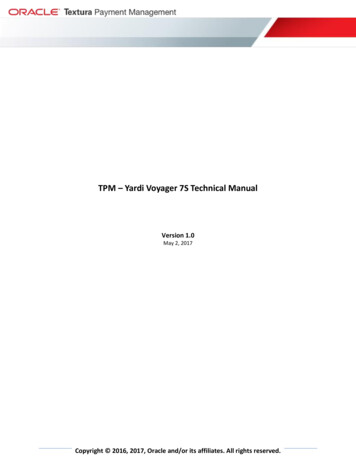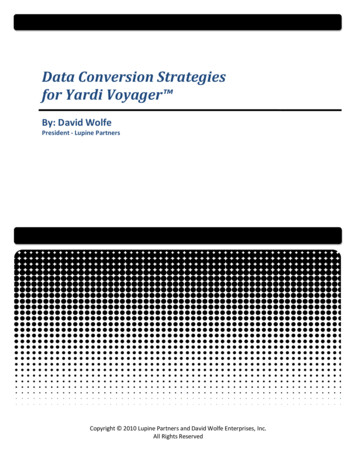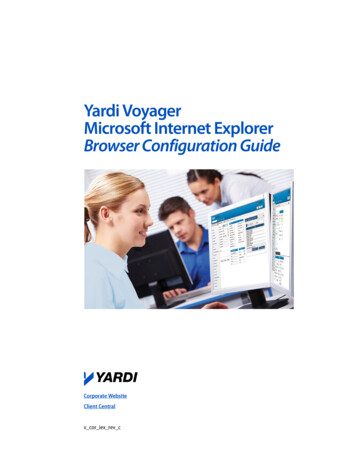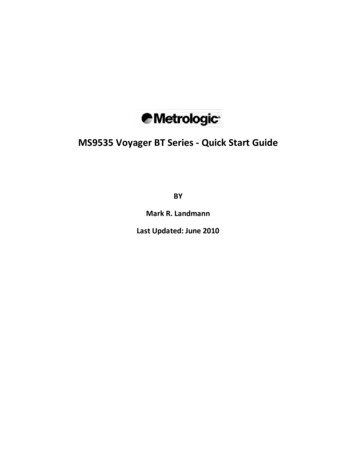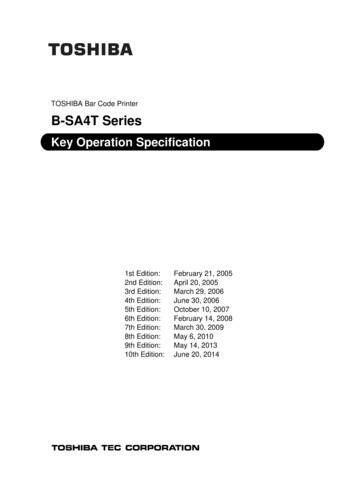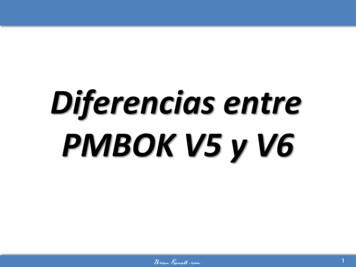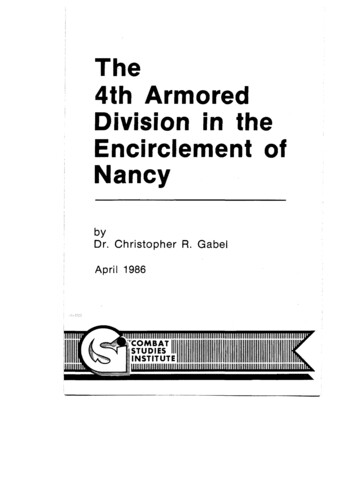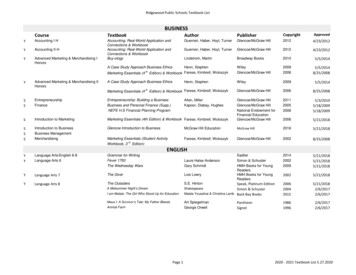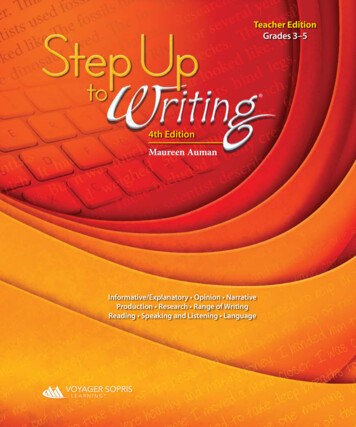
Transcription
Teacher EditionGrades 3–54th EditionMaureen AumanInformative/Explanatory Opinion NarrativeProduction Research Range of WritingReading Speaking and Listening Language
Teacher EditionGrades 3–54th EditionMaureen AumanInformative/Explanatory Opinion NarrativeProduction Research Range of WritingReading Speaking and Listening Language
Copyright 2015 Voyager Sopris Learning, Inc.All rights reserved.Step Up to Writing is a registered trademark ofVoyager Sopris Learning.1 2 3 4 5 WEB 18 17 16 15 14Permission is granted to the purchasing teacher to reproduce the blackline mastersfor use in his or her classroom only. No other portion of this work may be reproducedor transmitted in any form or by any means, electronic or mechanical, includingphotocopying or recording, or by any information storage and retrieval system,without the express written permission of the publisher.ISBN 13: 978-1-4916-9047-5ISBN 10: 1-4916-9047-XJDE: 334676/07-14Printed in the United States of AmericaPublished and Distributed by17855 Dallas Parkway, Suite 400 Dallas, TX 75287 800-547-6747www.voyagersopris.com
Meet the Author of Step Up to WritingMy journey with Step Up to Writing started in a classroom filledwith eighth graders anxious to head to high school and nervousabout passing eighth-grade exams. The challenge of preparingstudents to reach proficient or advanced levels on district and state writingassessments forced me to rethink the way I taught writing.I analyzed the skills that students needed to master and broke instruction into small steps.Then, I taught these one at a time using direct, explicit instruction as well as a workshopapproach. Students participated in active, hands-on lessons after seeing demonstrationson how to organize information, create topic sentences and introductions, and supporttopics with facts, details, and elaboration.Test scores validated the improvements I saw in the classroom. More importantly,students were on task and willing to write. They liked the clear, simple directions thatsaved them time, provided a structure, and encouraged them toshare their ideas.Step Up to Writing 4th Editionhas been developed to preparestudents to be proficient writersfor the 21st century whilemaintaining the same explicitinstruction and workshopapproach that first engagedand improved the skills of mystudents over two decades ago.Word spread first among my fellow language arts teachers, then tothe rest of the school, and eventually outside the district. Thousandsof teachers in and out of the United States now use Step Up to Writingstrategies every day in K–12 classrooms.My hope is that Step Up to Writing 4th Edition will inspire evenmore teachers to make all lessons active and multisensory—guaranteeing the academic success of students everywhere.Teacher Edition Grades 3–5iii
TABLE OF CONTENTSWelcome to Step Up to Writing!INTRODUCTION . . . . . . . . . . . . . . . . . . . . . . . . . . . iiiWelcome to Step Up to Writing! . . . . . . . . . . . . . . . . F8Research-Based Instructional Design. . . . . . . . . . . . F9A Comprehensive Writing Program. . . . . . . . . . . . F10What Can Step Up to WritingStudents Achieve?. . . . . . . . . . . . . . . . . . . . . . . . . . . . F15E1-20 Using Two-Column Notes forLiterature. . . . . . . . . . . . . . . . . . . . . . . . . . . 43E1-21 Three- and Four-Column Notes. . . . . . . . 45E1-22 Developing Study Guides. . . . . . . . . . . . . . 47E1-23 Mapping and Webbing . . . . . . . . . . . . . . . 49Summarizing Text . . . . . . . . . . . . . . . . . . . . . . . 51How Does Step Up to WritingSupport Teachers? . . . . . . . . . . . . . . . . . . . . . . . . . . . F17E1-24 Three-Column Notes with Summaries. . . 52A Guide for Using Step Up to Writingin the Classroom. . . . . . . . . . . . . . . . . . . . . . . . . . . . . F21E1-26 Plot Line Summaries. . . . . . . . . . . . . . . . . . 56Schoolwide Implementation. . . . . . . . . . . . . . . . . . . F25E1-25 Four-Step Summary Paragraphs. . . . . . . . 54E1-27 Summaries without Words. . . . . . . . . . . . 58E1-28 Money Summaries . . . . . . . . . . . . . . . . . . . 60 Writing to ImproveReading Comprehension . . . . . . . . 1E1-29 The 12-Word Trick. . . . . . . . . . . . . . . . . . . 62Responding to Text. . . . . . . . . . . . . . . . . . . . . . . 5E1-30 Asking and Answering Questions whileReading. . . . . . . . . . . . . . . . . . . . . . . . . . . . . 651Analyzing Text . . . . . . . . . . . . . . . . . . . . . . . . . . 64E1-1Free Responses . . . . . . . . . . . . . . . . . . . . . . . 6E1-2Response Starters . . . . . . . . . . . . . . . . . . . . . 7E1-3Reading Notation Responses. . . . . . . . . . . . 9E1-4Sticky Note Responses. . . . . . . . . . . . . . . . 11E1-5One-Word Responses. . . . . . . . . . . . . . . . . 12E1-6Agree/Disagree Responses. . . . . . . . . . . . . 14E1-7Quotation Responses. . . . . . . . . . . . . . . . . 16E1-34 Using Graphic Organizers to AnalyzeText Structure. . . . . . . . . . . . . . . . . . . . . . . 73E1-8 Framed Responses . . . . . . . . . . . . . . . . . . . 18E1-35 Comparing and Contrasting Texts. . . . . . 76Two-Column Guided Reponses. . . . . . . . 20Using and Creating Bookmarks . . . . . . . . . . . . 78E1-9E1-10 Quick Sketch Responses. . . . . . . . . . . . . . . 22E1-11 What Were You Thinking? . . . . . . . . . . . . 24E1-12 Text Connections. . . . . . . . . . . . . . . . . . . . 26Marking the Text . . . . . . . . . . . . . . . . . . . . . . . . 28E1-13 Highlighting and Underlining . . . . . . . . . 28E1-14 Mark Once. . . . . . . . . . . . . . . . . . . . . . . . . . 30E1-31 Making Inferences from Text. . . . . . . . . . 67E1-32 Making Inferences and Analyzing Textwith Informal Outlines. . . . . . . . . . . . . . . . 69E1-33 Making Inferences and AnalyzingText with Topic Sentences. . . . . . . . . . . . . 71E1-36 Three-Column Burrito FoldBookmarks. . . . . . . . . . . . . . . . . . . . . . . . . . 78E1-37 Sticky Note Bookmarks: Respondand Summarize. . . . . . . . . . . . . . . . . . . . . . 80E1-38 Two-Column Notes Bookmarks. . . . . . . . 82E1-39 Reminder Cut-Apart Bookmarks. . . . . . . 83E1-15 Circle Once, Underline Twice. . . . . . . . . . 32Progress Monitoring . . . . . . . . . . . . . . . . . . . . . 85E1-16 Pick a Number. . . . . . . . . . . . . . . . . . . . . . . 34E1-40 Quick Check for Note Taking. . . . . . . . . . 86Taking Notes. . . . . . . . . . . . . . . . . . . . . . . . . . . . 36E1-17 Collecting Facts. . . . . . . . . . . . . . . . . . . . . . 37E1-18 Easy Two-Column Notes. . . . . . . . . . . . . . 39F1E1-19 One Idea per Paragraph Note Taking . . . 41Teacher Edition Grades 3–5E1-41 Summary Writing Scoring Guide. . . . . . . 88
2Foundational Writing Skills. . . . 91Introduction to Writing. . . . . . . . . . . . . . . . . . . 96Masterful Sentences . . . . . . . . . . . . . . . . . . . . 157E2-29 Parts of a Sentence . . . . . . . . . . . . . . . . . . 158E2-30 Complete Sentences. . . . . . . . . . . . . . . . . 160E2-1Introducing Three Types of Writing. . . . 97E2-2Prompts for Three Types of Writing. . . 100E2-3Analyzing a Prompt. . . . . . . . . . . . . . . . . 102E2-32 Sentences Telling Who, What, Where,When, Action, and How . . . . . . . . . . . . . 164E2-4Recognizing the Traits of EffectiveWriting. . . . . . . . . . . . . . . . . . . . . . . . . . . . 104E2-33 Better Sentences . . . . . . . . . . . . . . . . . . . . 167E2-5Using a Computer to Write. . . . . . . . . . . 106E2-6Practicing Keyboarding Skills. . . . . . . . . 109E2-35 Combining Kinds of Sentences withSentence Structures. . . . . . . . . . . . . . . . . . 171E2-7Practicing Cursive Writing Skills. . . . . . 111E2-36 Sentence Variety. . . . . . . . . . . . . . . . . . . . 173E2-8 Formal and Informal Language . . . . . . . 113E2-37 Making Sentences Shorter or Longer. . . 176The Writing Process. . . . . . . . . . . . . . . . . . . . . 115E2-38 Writing Perfect Sentences. . . . . . . . . . . . 178E2-9The Writing Process. . . . . . . . . . . . . . . . . 116E2-10 Prewriting: Brainstorming. . . . . . . . . . . . 118E2-31 Kinds of Sentences . . . . . . . . . . . . . . . . . . 162E2-34 Sentence Structures. . . . . . . . . . . . . . . . . . 169E2-39 Using Commas Correctly . . . . . . . . . . . . 180E2-40 Making Subjects and Verbs Agree. . . . . 181E2-11 Prewriting: The Organization Game . . . 119Perfect Paragraphs. . . . . . . . . . . . . . . . . . . . . . 183E2-12 Revising . . . . . . . . . . . . . . . . . . . . . . . . . . . 121E2-41 Color-Coding the Elements of anInformative/Explanatory Paragraph . . . 184E2-13 Editing and Proofreading . . . . . . . . . . . . 123E2-14 Formatting a Formal Paper. . . . . . . . . . . 125E2-15 Practicing Proofreading. . . . . . . . . . . . . . 127E2-16 Options for Sharing and PublishingWriting. . . . . . . . . . . . . . . . . . . . . . . . . . . . 129Conventions of Standard English. . . . . . . . . . 131E2-42 Using Colored Paper Strips to Plana Paragraph . . . . . . . . . . . . . . . . . . . . . . . . 186E2-43 Planning Paragraphs with InformalOutlines . . . . . . . . . . . . . . . . . . . . . . . . . . . 189E2-44 Topic Sentences. . . . . . . . . . . . . . . . . . . . . 191E2-45 Perfect Three-Sentence Paragraphs. . . . 194E2-17 Recognizing Parts of Speech. . . . . . . . . . 132E2-46 Accordion Paragraphs. . . . . . . . . . . . . . . 196E2-18 Using Nouns . . . . . . . . . . . . . . . . . . . . . . . 134E2-47 Accordion Race. . . . . . . . . . . . . . . . . . . . . 198E2-19 Using Pronouns. . . . . . . . . . . . . . . . . . . . . 136E2-48 Stretch, Don’t Stack, Your Paragraph . . 200E2-20 Using Verbs. . . . . . . . . . . . . . . . . . . . . . . . 138E2-49 Definition and Function ofTransitions. . . . . . . . . . . . . . . . . . . . . . . . . 202E2-21 Avoiding Shifts in Verb Tense . . . . . . . . 140E2-22 Using Adjectives. . . . . . . . . . . . . . . . . . . . 142E2-23 Using Adverbs. . . . . . . . . . . . . . . . . . . . . . 144E2-24 Using Conjunctions. . . . . . . . . . . . . . . . . 145E2-25 Using Prepositions. . . . . . . . . . . . . . . . . . 148E2-26 Spelling Strategies. . . . . . . . . . . . . . . . . . . 150E2-27 Writing Titles of Works. . . . . . . . . . . . . . 152E2-28 Punctuating Dialogue andQuotations. . . . . . . . . . . . . . . . . . . . . . . . . 154E2-50 Using Transition Words for DifferentPurposes. . . . . . . . . . . . . . . . . . . . . . . . . . . 204E2-51 Learning about Elaboration . . . . . . . . . . . 207E2-52 Connecting the Conclusion to theTopic Sentence . . . . . . . . . . . . . . . . . . . . . 209E2-53 Improving Paragraphs with theABC Activity. . . . . . . . . . . . . . . . . . . . . . . 210E2-54 Analyzing a Paragraph. . . . . . . . . . . . . . . 212Teacher Edition Grades 3–5F2
TABLE OF CONTENTS(continued)Progress Monitoring . . . . . . . . . . . . . . . . . . . . 215Improving Word Choice. . . . . . . . . . . . . . . . . . 267E2-55 Neat Paper Rules. . . . . . . . . . . . . . . . . . . . 216E3-19 Choosing Words for Effect . . . . . . . . . . . 267E2-56 Quick Check for Sentences andTopic Sentences. . . . . . . . . . . . . . . . . . . . . 218E3-20 Getting Caught in the Things Trap:Using Precise Words . . . . . . . . . . . . . . . . 270E2-57 Quick Check for Parts of Speech . . . . . . 220E3-21 Revising “To Be” Verbs. . . . . . . . . . . . . . 271 Vocabulary Acquisitionand Use. . . . . . . . . . . . . . . . . . . . . . . . . . . 223Progress Monitoring . . . . . . . . . . . . . . . . . . . . 274Using Vocabulary Resources. . . . . . . . . . . . . . 227 Informative/ExplanatoryWriting: Stating the Facts . . . . 2793E3-1Reading Definitions in Dictionaries andGlossaries. . . . . . . . . . . . . . . . . . . . . . . . . . 228E3-2Breaking Down Definitions. . . . . . . . . . . 230E3-3Using Pronunciation Guides. . . . . . . . . . 232E3-4Using a Thesaurus. . . . . . . . . . . . . . . . . . . 234E3-22 Answering Vocabulary Questions. . . . . 2754Planning, Organization, and Structure. . . . . . 284E4-1Color-Coding the Elements of anInformative/Explanatory Paragraph . . . 285E4-2Planning a Paragraph with anInformal Outline. . . . . . . . . . . . . . . . . . . . 287E4-3Informal Outlines of Various Lengthsfor an Informative/ExplanatoryParagraph. . . . . . . . . . . . . . . . . . . . . . . . . . 289E4-4Accordion Paragraphs. . . . . . . . . . . . . . . 291E4-5Organization with FramedParagraphs. . . . . . . . . . . . . . . . . . . . . . . . . 293E4-6Elements of Informative/ExplanatoryEssays and Reports. . . . . . . . . . . . . . . . . . 294E4-7Blocking Out Essays and Reports. . . . . . 297E4-8Informal Outlines for Essaysand Reports. . . . . . . . . . . . . . . . . . . . . . . . 299E3-13 Using Context Clues to DetermineMeaning. . . . . . . . . . . . . . . . . . . . . . . . . . . 252E4-9Stretch, Don’t Stack: Essaysand Reports. . . . . . . . . . . . . . . . . . . . . . . . 302E3-14 Using Synonyms and Antonyms toDetermine Meaning. . . . . . . . . . . . . . . . . 255E4-10 Writing Essays and Reports Stepby Step. . . . . . . . . . . . . . . . . . . . . . . . . . . . . 304E3-15 Using Word Roots to DetermineMeaning. . . . . . . . . . . . . . . . . . . . . . . . . . . 257Introductions . . . . . . . . . . . . . . . . . . . . . . . . . . 308Practicing and Expanding Vocabulary . . . . . . 236E3-5Writing Meaningful VocabularySentences . . . . . . . . . . . . . . . . . . . . . . . . . . 237E3-6Vocabulary Maps . . . . . . . . . . . . . . . . . . . 239E3-7Concept Maps for Vocabulary Words. . 241E3-8 Vocabulary Study Guides . . . . . . . . . . . . 243E3-9Vocabulary Note Cards. . . . . . . . . . . . . . 245E3-10 Sorting Words into Categories. . . . . . . . 247E3-11 Recognizing and Using MultipleMeaning Words. . . . . . . . . . . . . . . . . . . . . 248E3-12 Homophones and Homographs. . . . . . . 250E3-16 Using Affixes to Determine Meaning . . 259E3-17 Figurative Language. . . . . . . . . . . . . . . . . 261E3-18 Using Idioms and Proverbs. . . . . . . . . . . 264E4-11 Defining a Topic Sentence. . . . . . . . . . . . 309E4-12 Turning a Writing Prompt into aTopic Sentence . . . . . . . . . . . . . . . . . . . . . 311E4-13 Topic Sentence Variety . . . . . . . . . . . . . . 313E4-14 Creating Two-Sentence Introductionsfor Essays and Reports. . . . . . . . . . . . . . . 318E4-15 Leading with the Blues. . . . . . . . . . . . . . . 320E4-16 Adding a Lead—The Blues . . . . . . . . . . . 322F3Teacher Edition Grades 3–5
Developing the Topic/Elaboration . . . . . . . . . 324Progress Monitoring . . . . . . . . . . . . . . . . . . . . 366E4-17 Facts vs. Opinions. . . . . . . . . . . . . . . . . . . 324E4-35 Informative/Explanatory ParagraphScoring Guide . . . . . . . . . . . . . . . . . . . . . . 367E4-18 Paragraph Elaboration—The E’s/the Reds . . . . . . . . . . . . . . . . . . . . 326E4-19 Increasing Elaboration. . . . . . . . . . . . . . . 328E4-20 Comparing Paragraph and ReportElaboration. . . . . . . . . . . . . . . . . . . . . . . . . 329Transitions . . . . . . . . . . . . . . . . . . . . . . . . . . . . 332E4-21 Using a Variety of Transitions . . . . . . . . 332E4-36 Informative/Explanatory Essay andReport Scoring Guide. . . . . . . . . . . . . . . . 370 Opinion Writing: Supportinga Point of View. . . . . . . . . . . . . . . . . . 3755Planning, Organization, and Structure. . . . . . 380E4-22 Transitions in Paragraphs vs. Essaysand Reports. . . . . . . . . . . . . . . . . . . . . . . . 334E5-1Defining Opinions and Reasons. . . . . . . 381E5-2E4-23 Transition Topic Sentences in Essaysand Reports. . . . . . . . . . . . . . . . . . . . . . . . 337Color-Coding the Elements of anOpinion Paragraph. . . . . . . . . . . . . . . . . . 383E5-3E4-24 Moving Away from ObviousTransitions. . . . . . . . . . . . . . . . . . . . . . . . . 339Planning an Opinion Paragraph withan Informal Outline. . . . . . . . . . . . . . . . . 385E5-4Accordion Paragraphs for OpinionWriting. . . . . . . . . . . . . . . . . . . . . . . . . . . . 388Conclusions . . . . . . . . . . . . . . . . . . . . . . . . . . . 342E5-5E4-25 Conclusions for Informative/ExplanatoryWriting. . . . . . . . . . . . . . . . . . . . . . . . . . . . 342Elements of Opinion Essaysand Reports. . . . . . . . . . . . . . . . . . . . . . . . 390E5-6Blocking Out Opinion Essaysand Reports. . . . . . . . . . . . . . . . . . . . . . . . 392E5-7Informal Outlines for OpinionEssays and Reports. . . . . . . . . . . . . . . . . . 394E5-8Writing Opinion Essays and ReportsStep by Step. . . . . . . . . . . . . . . . . . . . . . . . 398E4-26 Writing Successful Conclusions. . . . . . . 344E4-27 Practicing and ImprovingConclusions. . . . . . . . . . . . . . . . . . . . . . . . 345Incorporating Graphics and Text Features . . . 348E4-28 Text Features and Formatting. . . . . . . . . 348E4-29 Adding Pictures and Graphics . . . . . . . . 351E4-30 Multimedia in Informative/ExplanatoryWriting. . . . . . . . . . . . . . . . . . . . . . . . . . . . 353Revising and Editing . . . . . . . . . . . . . . . . . . . . 356E4-31 Revising Informative/ExplanatoryWriting. . . . . . . . . . . . . . . . . . . . . . . . . . . . 357E4-32 Writing in First, Second, andThird Person . . . . . . . . . . . . . . . . . . . . . . . 360E4-33 Incorporating and DefiningDomain-Specific Vocabulary . . . . . . . . . 362E4-34 Editing Informative/ExplanatoryWriting. . . . . . . . . . . . . . . . . . . . . . . . . . . . 364Introductions . . . . . . . . . . . . . . . . . . . . . . . . . . 402E5-9Stating an Opinion in a TopicSentence. . . . . . . . . . . . . . . . . . . . . . . . . . . 403E5-10 Topic Sentence Variety in OpinionWriting. . . . . . . . . . . . . . . . . . . . . . . . . . . . 405E5-11 Focus on the Audience. . . . . . . . . . . . . . . 410E5-12 Two-Sentence Introductions forOpinion Essays and Reports. . . . . . . . . . 412E5-13 Introducing an Opinion and Leadingwith the Blues . . . . . . . . . . . . . . . . . . . . . . 414E5-14 Opinion Writing: Adding a Lead—The Blues . . . . . . . . . . . . . . . . . . . . . . . . . . 417Teacher Edition Grades 3–5F4
TABLE OF CONTENTS(continued)Developing the Opinion/Elaboration. . . . . . . 419E6-4E5-15 Elaboration in Opinion Writing—The E’s/the Reds . . . . . . . . . . . . . . . . . . . . 419Turning a Writing Prompt intoa Narrative. . . . . . . . . . . . . . . . . . . . . . . . . 471E6-5Prewriting with a Story Map. . . . . . . . . . 473E5-16 Using the EITHER-OR Strategies inOpinion Writing. . . . . . . . . . . . . . . . . . . . 421E6-6Quick Sketch and Quick NotePlanning. . . . . . . . . . . . . . . . . . . . . . . . . . . 476E5-17 Better Elaboration. . . . . . . . . . . . . . . . . . . 423E6-7Six Steps for Writing a Narrative. . . . . . . 479E5-18 Increasing Elaboration in OpinionWriting. . . . . . . . . . . . . . . . . . . . . . . . . . . . 425E6-8 Sequencing Events . . . . . . . . . . . . . . . . . . 481Transitions . . . . . . . . . . . . . . . . . . . . . . . . . . . . 427E5-19 Transitions for Opinion Writing. . . . . . 427E5-20 Using Transitions to ConnectOpinions and Reasons. . . . . . . . . . . . . . . 429Preparing to Write: RAFTS. . . . . . . . . . . 483E6-10 Planning and Developing Characters . . 485E6-11 Planning for Changes in Characters . . . 487E6-12 The Narrator: Writing in First, Second,or Third Person. . . . . . . . . . . . . . . . . . . . . 489E5-21 Using Transition Topic Sentences inOpinion Essays and Reports. . . . . . . . . . 432Beginnings . . . . . . . . . . . . . . . . . . . . . . . . . . . . 491Conclusions . . . . . . . . . . . . . . . . . . . . . . . . . . . 435E6-14 Three-Step Strategy to Writea Beginning . . . . . . . . . . . . . . . . . . . . . . . . 493E5-22 Supporting the Opinion in aConclusion. . . . . . . . . . . . . . . . . . . . . . . . . 435E5-23 Writing Successful Conclusions forOpinion Writing. . . . . . . . . . . . . . . . . . . . 438E5-24 Practicing Conclusions forOpinion Writing. . . . . . . . . . . . . . . . . . . . 439Revising and Editing . . . . . . . . . . . . . . . . . . . . 442E5-25 Revising Opinion Writing. . . . . . . . . . . . 442E5-26 First, Second, and Third Person inOpinion Writing. . . . . . . . . . . . . . . . . . . . 446E5-27 Editing Opinion Writing. . . . . . . . . . . . . 448Progress Monitoring . . . . . . . . . . . . . . . . . . . . 451E5-28 Opinion Paragraph Scoring Guide. . . . . 452E5-29 Opinion Essay and ReportScoring Guide . . . . . . . . . . . . . . . . . . . . . . 455 Narrative Writing:Telling a Story. . . . . . . . . . . . . . . . . . . 4596Planning, Organization, and Structure. . . . . . 464F5E6-9E6-1Types of Narratives. . . . . . . . . . . . . . . . . . 465E6-2Color-Coding Narrative Writing. . . . . . 467E6-3Generating Ideas for NarrativeWriting. . . . . . . . . . . . . . . . . . . . . . . . . . . . 469Teacher Edition Grades 3–5E6-13 Ways to Begin a Narrative. . . . . . . . . . . . 491Drafting and Using Narrative Techniques . . . 496E6-15 Moving from a Plan to a Draft . . . . . . . . 497E6-16 Writing Dialogue . . . . . . . . . . . . . . . . . . . 499E6-17 Pacing in Narrative Writing . . . . . . . . . . 502E6-18 Showing—Not Telling. . . . . . . . . . . . . . . 504E6-19 Eight Tips for Writing a NarrativeFirst Draft. . . . . . . . . . . . . . . . . . . . . . . . . . 506E6-20 Qualities of a Good Narrative. . . . . . . . . 508Transitions . . . . . . . . . . . . . . . . . . . . . . . . . . . . 511E6-21 Using Transitions in Narratives. . . . . . . 511E6-22 Practice Hunting for NarrativeTransitions. . . . . . . . . . . . . . . . . . . . . . . . . 513Ends. . . . . . . . . . . . . . . . . . . . . . . . . . . . . . . . . . 516E6-23 Options for Writing the End ofa Narrative. . . . . . . . . . . . . . . . . . . . . . . . . 516E6-24 Connecting the Beginning and Endof a Narrative. . . . . . . . . . . . . . . . . . . . . . . 518Personal Narratives . . . . . . . . . . . . . . . . . . . . . 520E6-25 Color-Coding Personal Narratives. . . . . 520E6-26 Preparing to Write PersonalNarratives. . . . . . . . . . . . . . . . . . . . . . . . . . 523E6-27 Planning a Personal Narrative . . . . . . . . 526
Revising and Editing . . . . . . . . . . . . . . . . . . . . 528E7-18 Revising a Research Report. . . . . . . . . . . 595E6-28 Revising Narratives. . . . . . . . . . . . . . . . . . 528E7-19 Editing and Finalizing a ResearchReport. . . . . . . . . . . . . . . . . . . . . . . . . . . . . 597E6-29 Tips for Revising Personal Narratives. . 531E6-30 Editing Narrative Writing. . . . . . . . . . . . 533Progress Monitoring . . . . . . . . . . . . . . . . . . . . 535E6-31 Imaginative and Nonfiction NarrativeScoring Guide . . . . . . . . . . . . . . . . . . . . . . 536E6-32 Personal Narrative Scoring Guide . . . . . 5397 Research Reports. . . . . . . . . . . . . . . 543E7-20 Using Technology to Produce, Publish,and Present a Research Report. . . . . . . . 599Progress Monitoring . . . . . . . . . . . . . . . . . . . . 601E7-21 Research Report Scoring Guide . . . . . . . 6028 Speaking and Listening. . . . . . . . 605Organizing and Planning a Presentation . . . . 609Research Reports: Overview. . . . . . . . . . . . . . 547E8-1Components of a Good Presentation. . . 610E7-1Elements of Research Reports. . . . . . . . . 548E8-2Informal Outline for a Presentation. . . . 612E7-2Steps for Writing a Research Report . . . 551E8-3E7-3Choosing a Topic . . . . . . . . . . . . . . . . . . . 554Planning to Tell a Story orExperience. . . . . . . . . . . . . . . . . . . . . . . . . 615E7-4Narrowing a Research Topic. . . . . . . . . . 556E8-4Train of Thought. . . . . . . . . . . . . . . . . . . . 617E7-5Developing Research Questions:What Do I Want to Know?. . . . . . . . . . . 558E8-5Blocking Out a Presentation. . . . . . . . . . 619E8-6Consider the Audience. . . . . . . . . . . . . . . 621E8-7Planning Longer Presentations. . . . . . . . 623Finding and Evaluating Sources. . . . . . . . . . . 561E7-6Types of Sources: Primary andSecondary. . . . . . . . . . . . . . . . . . . . . . . . . . 562E7-7Researching Using Print Sources. . . . . . 564Types of Presentations . . . . . . . . . . . . . . . . . . 626E8-8 Making Introductions . . . . . . . . . . . . . . . 627E8-9Presenting Information or Research . . . 629E7-8 Researching Online. . . . . . . . . . . . . . . . . . 566E8-10 Impromptu Presentations. . . . . . . . . . . . 631Assessing and Comparing Sources. . . . . 569E8-11 Giving a How-To Presentation. . . . . . . . 633E7-9Gathering Information andPlanning Writing. . . . . . . . . . . . . . . . . . . . . . . . 572E7-10 Gathering Information from Sources . . 573E7-11 Research Note Cards . . . . . . . . . . . . . . . . 576E8-12 Presenting Your Opinion. . . . . . . . . . . . . 635E8-13 Oral Book Reports . . . . . . . . . . . . . . . . . . 638E8-14 Telling a Story or Recounting anExperience. . . . . . . . . . . . . . . . . . . . . . . . . 640E7-12 Sorting Information. . . . . . . . . . . . . . . . . 580Presentation Techniques. . . . . . . . . . . . . . . . . 642E7-13 Informal Outline for a ResearchReport. . . . . . . . . . . . . . . . . . . . . . . . . . . . . 582E8-15 Speaking Techniques. . . . . . . . . . . . . . . . 643Writing a Research Report. . . . . . . . . . . . . . . 585E8-17 Adding Images, Sound, and More. . . . . 647E7-14 Writing a First Draft. . . . . . . . . . . . . . . . . 586E8-18 Responding to Presentations. . . . . . . . . . 650E7-15 Using Quotations. . . . . . . . . . . . . . . . . . . 588E7-16 Paraphrasing Information fromSources. . . . . . . . . . . . . . . . . . . . . . . . . . . . 590E8-16 Using Formal English. . . . . . . . . . . . . . . . 645E8-19 Asking and Answering Questionsabout Presentations . . . . . . . . . . . . . . . . . 653E7-17 Creating a List of Sources . . . . . . . . . . . . 591Teacher Edition Grades 3–5F6
TABLE OF CONTENTS(continued)Collaboration and Discussion. . . . . . . . . . . . . 656E8-20 Good Listening Skills. . . . . . . . . . . . . . . . 657E8-21 Practicing Active Listening andDiscussion Skills. . . . . . . . . . . . . . . . . . . . 658E8-22 Participating in a Discussion. . . . . . . . . . 662E8-23 Peer Review. . . . . . . . . . . . . . . . . . . . . . . . 665E8-24 Collaborating in a Group. . . . . . . . . . . . . 667Progress Monitoring . . . . . . . . . . . . . . . . . . . . 669E8-25 Quick Check for Presentations. . . . . . . . 670E8-26 Quick Check for Collaboration. . . . . . . . 6729Writing for Assessments . . . . . 67510Types of Writing: Text Structure . . . . . . . . . . 719E10-1 Enumeration. . . . . . . . . . . . . . . . . . . . . . . 719E10-2 Compare/Contrast . . . . . . . . . . . . . . . . . . 721E10-3 Cause/Effect and Problem/Solution. . . . 724Specific Writing Assignments. . . . . . . . . . . . . 728E10-4 Writing in Math . . . . . . . . . . . . . . . . . . . . 729E10-5 Writing Science Reports . . . . . . . . . . . . . 731E10-6 Interviewing. . . . . . . . . . . . . . . . . . . . . . . . 733E10-7 Writing Biographical/AutobiographicalSketches . . . . . . . . . . . . . . . . . . . . . . . . . . . 735E9-1Great Short Answers. . . . . . . . . . . . . . . . . 680E9-2Not all Writing Requires a FormalConclusion. . . . . . . . . . . . . . . . . . . . . . . . . 683E9-3Using a Two-Column Study Guideto Answer Questions . . . . . . . . . . . . . . . . 685E9-4Identifying Types of ResponseQuestions. . . . . . . . . . . . . . . . . . . . . . . . . . 686E10-12 Writing Informal Letters. . . . . . . . . . . . . 747E9-5Understanding and UsingScoring Guides . . . . . . . . . . . . . . . . . . . . . 691E10-14 Writing E-mail . . . . . . . . . . . . . . . . . . . . . 751E9-6Extended Responses and EssayQuestions. . . . . . . . . . . . . . . . . . . . . . . . . . 694E10-16 Writing a Skit. . . . . . . . . . . . . . . . . . . . . . . 756E9-7Choosing Sources to AnswerQuestions. . . . . . . . . . . . . . . . . . . . . . . . . . 696E9-8 Referring to Sources in Answers. . . . . . . 698E9-9Simulating Standardized WritingAssessments. . . . . . . . . . . . . . . . . . . . . . . . 701E9-10 Multiple-Choice Questions aboutWriting. . . . . . . . . . . . . . . . . . . . . . . . . . . . 706E9-11 Writing for Timed Tests andAssessments. . . . . . . . . . . . . . . . . . . . . . . . 709E9-12 Computer-Based Assessments . . . . . . . . 711E9-13 Recording and Monitoring Progress. . . 713F7 Writing in theSubject Areas . . . . . . . . . . . . . . . . . . . 715Teacher Edition Grades 3–5E10-8 Writing to Persuade. . . . . . . . . . . . . . . . . 738E10-9 Writing a News Article. . . . . . . . . . . . . . . 740E10-10 Writing a Book Report. . . . . . . . . . . . . . . 742E10-11 Responding to Literature. . . . . . . . . . . . . 745E10-13 Writing Formal Letters . . . . . . . . . . . . . . 749E10-15 Writing Poetry. . . . . . . . . . . . . . . . . . . . . . 753Personal Writing. . . . . . . . . . . . . . . . . . . . . . . .
My hope is that Step Up to Writing 4th Edition will inspire even more teachers to make all lessons active and multisensory— guaranteeing the academic success of students everywhere. Step Up to Writing 4th Edition has been developed to prepare students to be proficient writers
